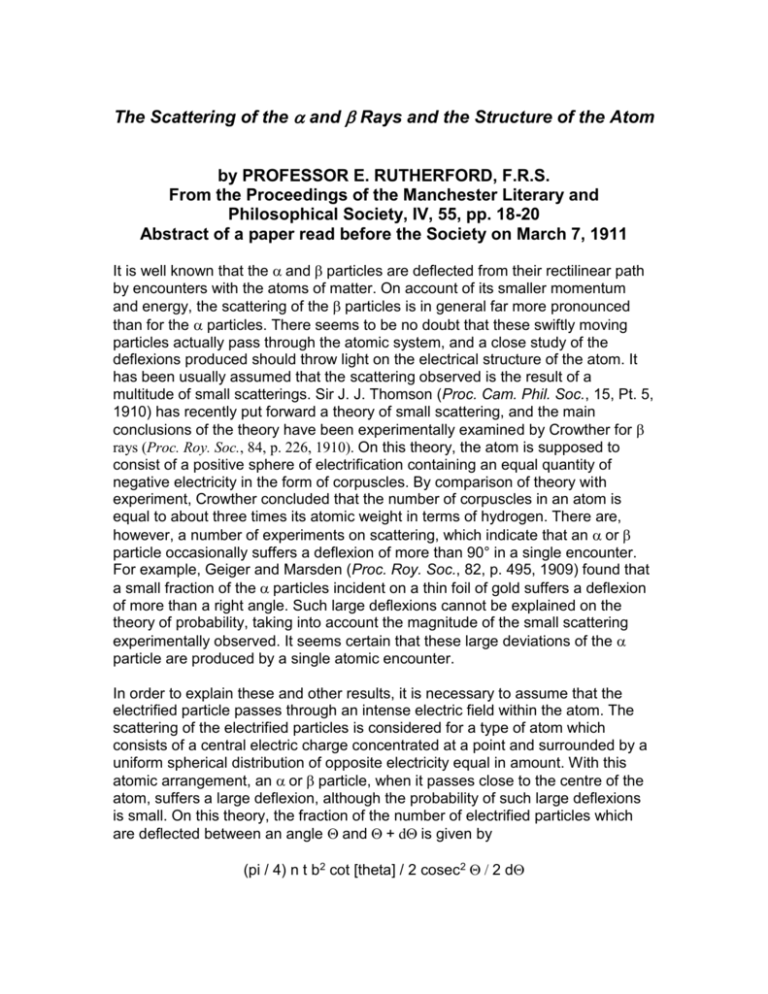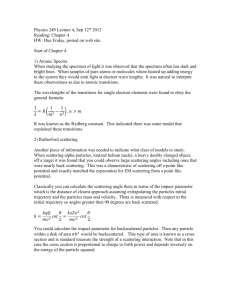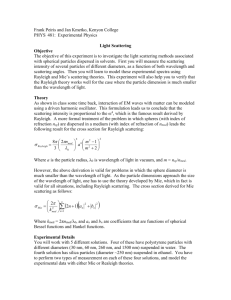Rutherford gold foil abstract
advertisement

The Scattering of the and Rays and the Structure of the Atom by PROFESSOR E. RUTHERFORD, F.R.S. From the Proceedings of the Manchester Literary and Philosophical Society, IV, 55, pp. 18-20 Abstract of a paper read before the Society on March 7, 1911 It is well known that the and particles are deflected from their rectilinear path by encounters with the atoms of matter. On account of its smaller momentum and energy, the scattering of the particles is in general far more pronounced than for the particles. There seems to be no doubt that these swiftly moving particles actually pass through the atomic system, and a close study of the deflexions produced should throw light on the electrical structure of the atom. It has been usually assumed that the scattering observed is the result of a multitude of small scatterings. Sir J. J. Thomson (Proc. Cam. Phil. Soc., 15, Pt. 5, 1910) has recently put forward a theory of small scattering, and the main conclusions of the theory have been experimentally examined by Crowther for rays (Proc. Roy. Soc., 84, p. 226, 1910). On this theory, the atom is supposed to consist of a positive sphere of electrification containing an equal quantity of negative electricity in the form of corpuscles. By comparison of theory with experiment, Crowther concluded that the number of corpuscles in an atom is equal to about three times its atomic weight in terms of hydrogen. There are, however, a number of experiments on scattering, which indicate that an or particle occasionally suffers a deflexion of more than 90° in a single encounter. For example, Geiger and Marsden (Proc. Roy. Soc., 82, p. 495, 1909) found that a small fraction of the particles incident on a thin foil of gold suffers a deflexion of more than a right angle. Such large deflexions cannot be explained on the theory of probability, taking into account the magnitude of the small scattering experimentally observed. It seems certain that these large deviations of the particle are produced by a single atomic encounter. In order to explain these and other results, it is necessary to assume that the electrified particle passes through an intense electric field within the atom. The scattering of the electrified particles is considered for a type of atom which consists of a central electric charge concentrated at a point and surrounded by a uniform spherical distribution of opposite electricity equal in amount. With this atomic arrangement, an or particle, when it passes close to the centre of the atom, suffers a large deflexion, although the probability of such large deflexions is small. On this theory, the fraction of the number of electrified particles which are deflected between an angle and + d is given by (pi / 4) n t b2 cot [theta] / 2 cosec2 / 2 d where n is the number of atoms per unit volume of the scattering material, t the thickness of material supposed small, and b = 2 Ne E / m u2 where Ne is the charge at the centre of the atom, E the charge on the electrified particle, m its mass, and u its velocity. It follows that the number of scattered particles per unit area for a constant distance from the point of incidence of the pencil of rays varies as cosec 4 / 2. This law of distribution has been experimentally tested by Geiger for a particles, and found to hold within the limit of experimental error. From a consideration of general results on scattering by different materials, the central charge of the atom is found to be very nearly proportional to its atomic weight. The exact value of the central charge has not been determined, but for an atom of gold it corresponds to about 100 unit charges. From a comparison of the theories of large and small scattering, it is concluded that the effects are mainly controlled by the large scattering, especially when the fraction of the number of particles scattered through considerable angles is small. The results obtained by Crowther are for the most part explained by this theory of large scattering although no doubt they are to a certain extent influenced by small scattering. It is concluded that for different materials the fraction of particles scattered through a large angle is proportional to NA2 where N is the number of atoms per unit volume, and A the atomic weight of the material. The main results of large scattering are independent of whether the central charge is positive or negative. It has not yet been found possible to settle this question of sign with certainty. This theory has been found useful in explaining a number of results connected with the scattering and absorption of and particles by matter. The main deductions from the theory are at present under examination in the case of the rays by Dr. Geiger using the scintillation method.








